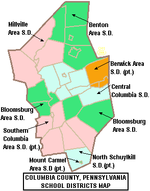Fishing Creek (North Branch Susquehanna River tributary)

Fishing Creek is a 29.98-mile (48.25 km) long tributary of the Susquehanna River in Columbia County, Pennsylvania, in the United States. It joins the Susquehanna River near the census-designated place of Rupert and the town of Bloomsburg. The watershed has an area of 385 square miles (1,000 km2). Nomadic Native Americans arrived in the lower reaches of Fishing Creek around 8000 BCE, and some were spending winters in the upper reaches of the valley by 3000 to 2000 BCE. In the past few centuries, the Fishing Creek area has been home to many industries, mills, and dams. It drains parts of five Pennsylvania counties: Columbia, Montour, Sullivan, Luzerne, and Lycoming. The creek's main tributaries include Hemlock Creek, Little Fishing Creek, Green Creek, Huntington Creek, West Branch Fishing Creek, and East Branch Fishing Creek. Public recreation activities include canoeing, birdwatching, and fishing. The creek is known for its trout population, which includes brook, brown and rainbow trout; it also contains many other species of fish. Northern hardwood trees and ruffed grouse live in the surrounding area. Some stretches of Fishing Creek contain significant amounts of algae because of leaking septic systems in the watershed. The area around the tributary West Creek is the least habitable part of the Fishing Creek area, according to a 2011 study. The water quality of Fishing Creek can vary. Its pH ranges from 4.9 to 8.5, while the concentration of dissolved oxygen ranges from 5 to 17.5 mg per liter. The creek's average discharge is 615 cubic feet per second (17.4 m3/s); its watershed contains gravel, shale and various loams—in particular the Albrights soil series and the Leck Kill soil.
Excerpt from the Wikipedia article Fishing Creek (North Branch Susquehanna River tributary) (License: CC BY-SA 3.0, Authors, Images).Fishing Creek (North Branch Susquehanna River tributary)
Fort McClure Boulevard,
Geographical coordinates (GPS) Address Phone number Website Nearby Places Show on map
Geographical coordinates (GPS)
| Latitude | Longitude |
|---|---|
| N 40.977222222222 ° | E -76.467222222222 ° |
Address
Indian Head Campground
Fort McClure Boulevard
17815
Pennsylvania, United States
Open on Google Maps










